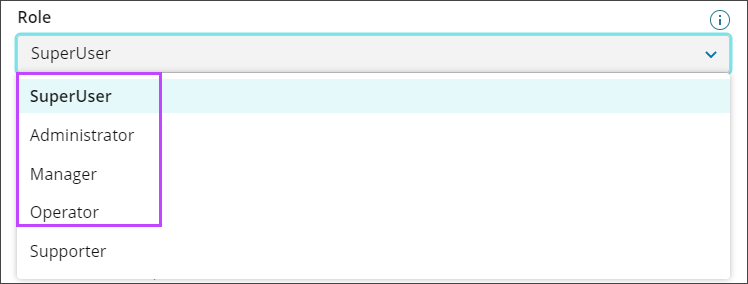Users (or user accounts) are required for access to the Console and other Cloud services.
- There are several user roles to choose from. They make it possible to differentiate access to data and features within a company.
-
Customers can have an unlimited number of users.
User roles
The following user roles are available:
- SuperUser
- Administrator
- Manager
- Operator
- Supporter
Security Officer is an additional setting which can be applied to certain roles to provide additional access to generate a passphrase:
- SuperUser
- Administrator
- Manager
- Operator
Key
The following icons indicate availability:
| Key | Status | Description |
|---|---|---|
|
|
Available | Is available for all |
|
|
Limited Availability | Is available for with limitations (see Note for additional information) |
|
|
Read Only | Is available in read only mode |
|
|
Not Available | Is not available |
Please see the table below for access permissions available to each of the roles.
| Task | SuperUser with security officer | SuperUser | Administrator with security officer | Administrator | Manager with security officer | Manager | Operator with security officer | Operator | Supporter |
|---|---|---|---|---|---|---|---|---|---|
| Adding devices |
|
|
|
|
|
|
|
|
|
| Export of monthly device statistics |
|
|
|
|
|
|
|
|
|
| Generating passphrases |
|
|
|
|
|
|
|
|
|
| Launching backup devices remotely |
|
|
|
|
|
|
|
|
|
| Recovering data in Backup Manager |
|
|
|
|
|
|
|
|
|
| Recovering data in Recovery Console |
|
|
|
|
|
|
|
|
|
| Recovery Testing |
|
|
|
|
|
|
|
|
|
| StandBy Image |
|
|
|
|
|
|
|
|
|
| Recovery Locations |
|
|
|
|
|
|
|
|
|
| Managing backup profiles |
|
|
|
|
|
|
|
|
|
| Managing contact notes |
|
|
|
|
|
|
|
|
|
| Managing contacts |
|
|
|
|
|
|
|
|
|
| Managing customers |
|
|
|
|
|
|
|
|
|
| Managing devices |
|
|
|
|
|
|
|
|
|
| Managing Microsoft 365 domains |
|
|
|
|
|
|
|
|
|
| Managing retention policies |
|
|
|
|
|
|
|
|
|
| Managing security officers |
|
|
|
|
|
|
|
|
|
| Managing users |
|
|
|
|
|
|
|
|
|
| Managing API users |
|
|
|
|
|
|
|
|
|
| Managing notifications |
|
|
|
|
|
|
|
|
|
| Managing views |
|
|
|
|
|
|
|
|
|
| Sending remote commands to devices |
|
|
|
|
|
|
|
|
|
Adding users
You can add new users for your own company and for your customers. Here are steps to follow:
- In the vertical menu, click Users
-
Click Add user
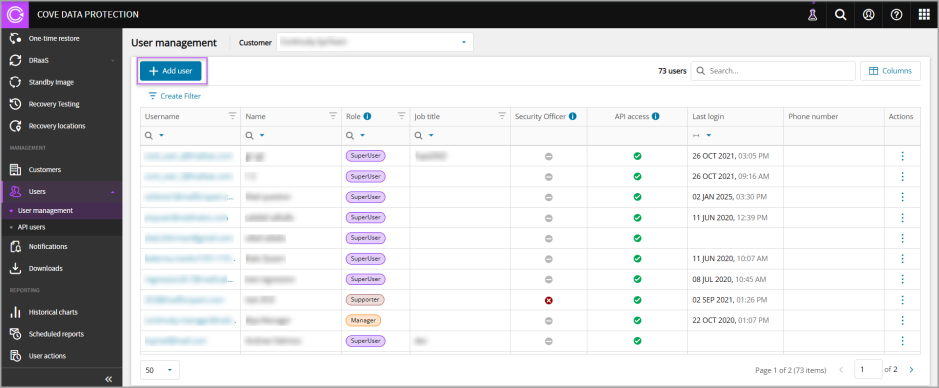
-
Fill out the fields as fully as you can
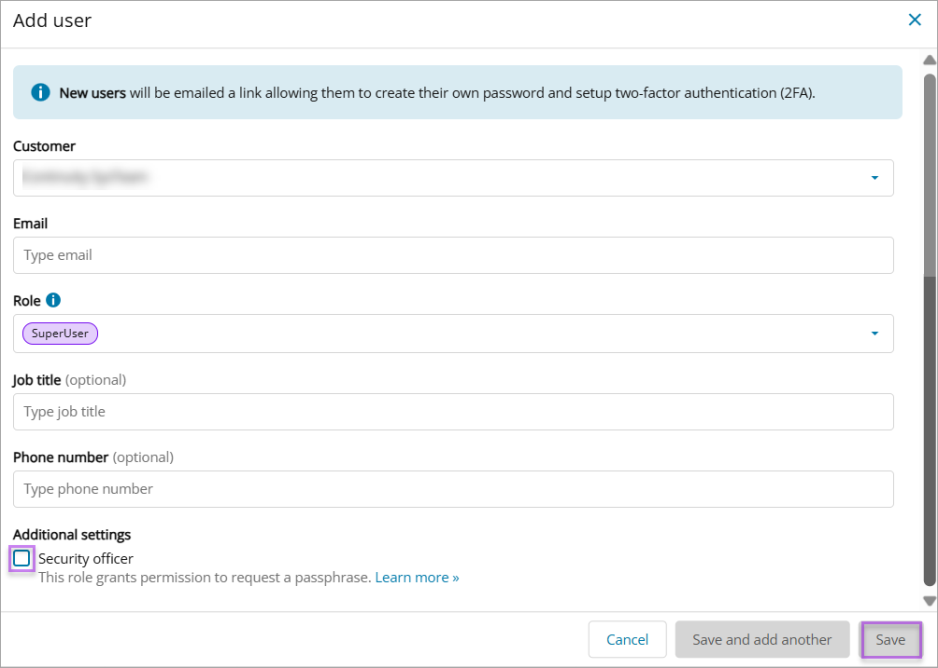
- Ensure you select Security Officer as this user role grants permission to request a passphrase
- Click Save to apply the changes
The owner of the new user account will get an email notification with a password setup link.
Adding API users
API users can access Cove's API but are restricted from logging into the Cove console.
You can add API users for your own company and for your customers. Here are the steps to follow:
-
In the vertical menu, click Users and then click API users. Click Add API user

You can navigate to the standard users dashboard by clicking User Management in the vertical menu.
-
Enter the fields in Add API User window
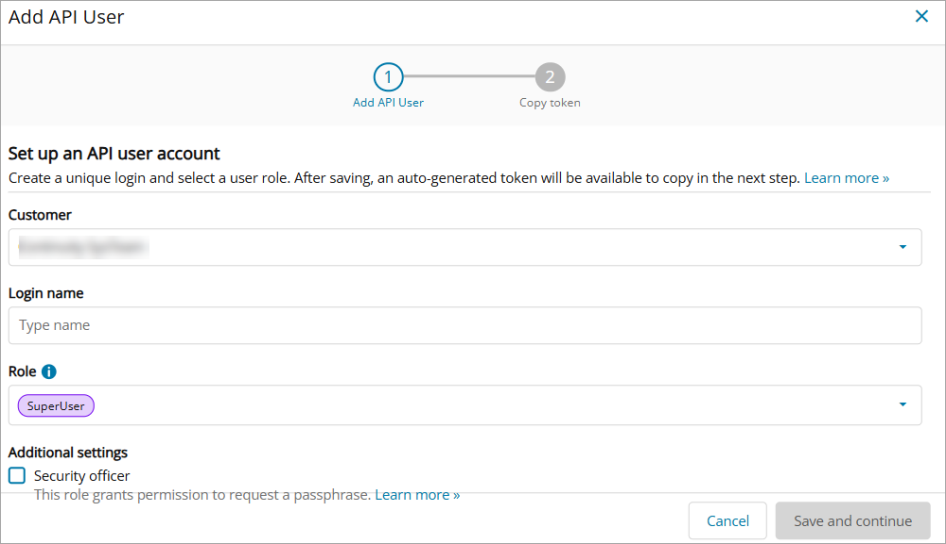
-
Ensure you select Security Officer as this user role grants permission to request a passphrase
-
Click Save and continue and copy the token in the Copy token window through Copy token to clipboard
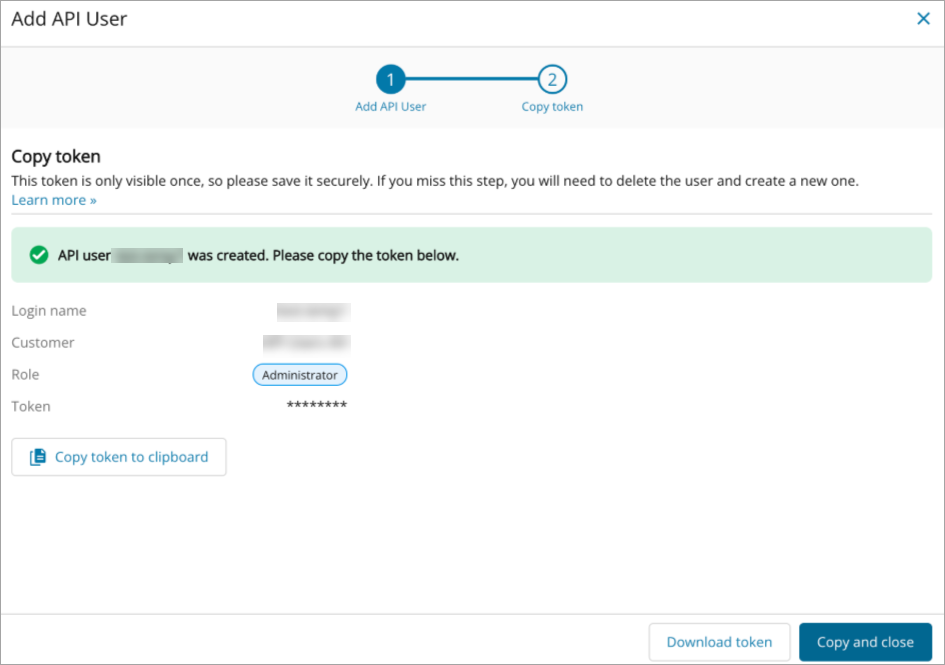
-
Click Download token to download the token
-
Click Copy and close to add the API user
This token is only visible once, so please save it securely. If you miss this step, you will need to delete the user and create a new one.
Editing users
You can change any of the settings configured for a user except for the log-in name. Here is how to:
-
Click the three dots under Actions next to the name of the user that you want to edit and click Edit user

-
Edit the settings as required and click Save to apply. You can click the icon next to the Customer, Email, and Name to copy to clipboard
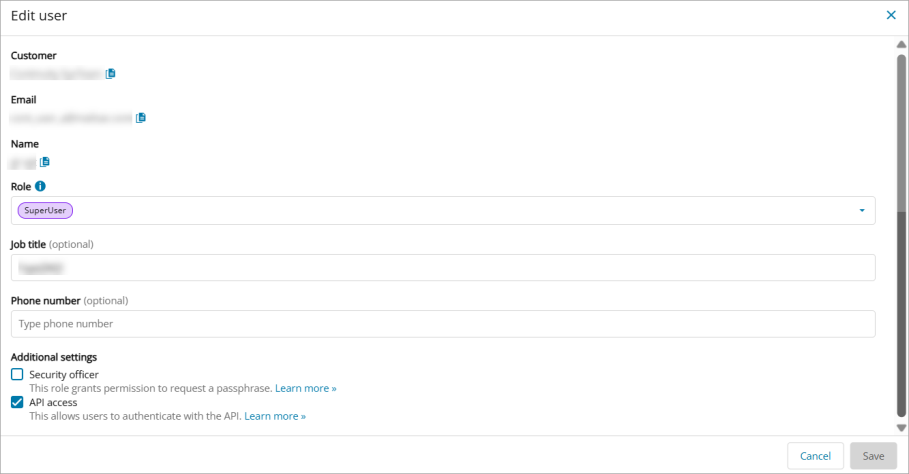
Under Additional settings, API access can be enabled and disabled for users through the edit user functionality.
Editing API users
-
Click the three dots under Actions next to the name of the user that you want to edit and click Edit user

-
Edit the data as required and click Save changes to apply. You can click the icon next to the Customer and Login name to copy to clipboard
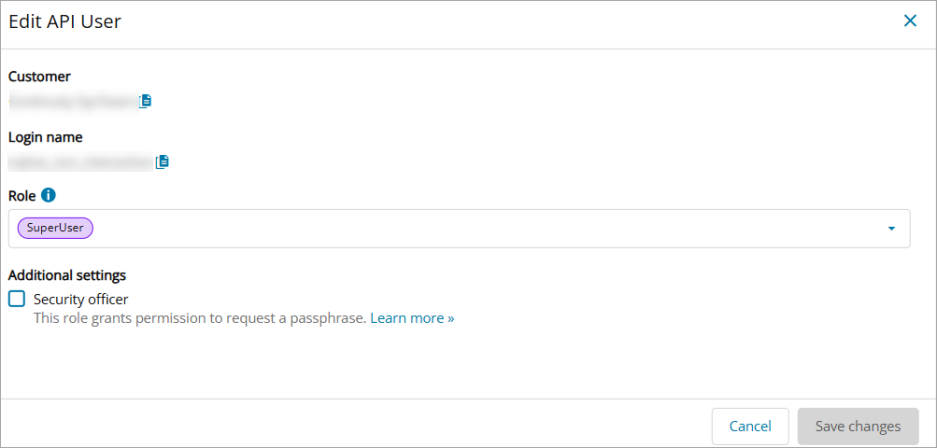
Removing users
Here is how to remove a user from the system:
-
Click the three dots under Actions next to the name of the user that you want to delete and click Delete user

-
Click Delete to delete a specific user, else click Cancel

After a user is removed, it will not be possible to access the Console with the deleted user account. All people logged in under that account will be logged out within the next 15 minutes.
Removing API users
-
Click the three dots under Actions next to the name of the user that you want to delete and click Delete user

-
Click Delete to delete a specific API user, else click Cancel
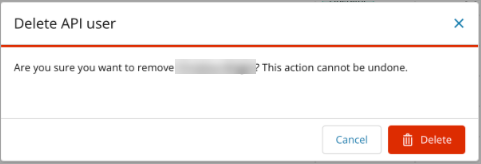
After an API user is removed, it is not possible to access Cove APIs with this user.
Managing security officers
The first SuperUser who logs in to the Console is immediately flagged as a security officer. Only security officers can manage other security officers including themselves.
To add a user with the security officer permissions, do the following:
- Log in to the Management Console as a user with security officer permissions
- Navigate to the User Management module
- Click Add user
- Set the user role to SuperUser, Administrator, Manager or Operator
- Select the Security officer checkbox
- Click Add
You can also grant or remove security officer permissions to existing SuperUsers if necessary (see Edit user dialogue).
Each customer of the reseller or end-customer level must have at least 1 security officer. You cannot delete the last security officer.
Single Sign-On
Users log into the Management Console through a Single Sign-On service.
Our N-able Login service is a convenient way for you to access our SSO products (including Take Control, MSP Manager and N-sight) with a single set of login credentials.
Please be aware that any changes to your SSO credentials, including username and password updates, will apply to all of our SSO supporting products and the N-ableMe.
Please visit N-able Login in Management Console for further information.

